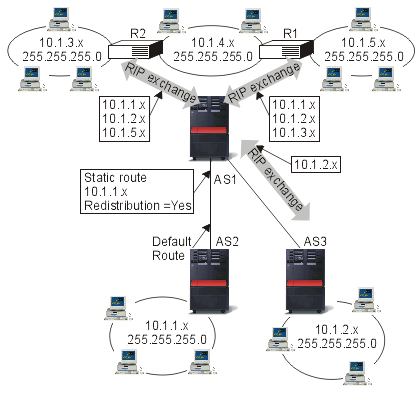Dynamic routing is a low-maintenance method that automatically reconfigures routing tables as your network changes.
Dynamic routing is provided by Interior Gateway Protocols (IGPs), such as Routing Internet Protocol (RIP). RIP allows you to configure the hosts as part of a RIP network. This type of routing requires little maintenance and also automatically reconfigures routing tables when your network changes or crashes. RIPv2 was added to the iSeries™ server so you can send and receive RIP packets to update routes throughout your network.
In the following figure, a static route is added to the central system (AS1) that describes the connection to the network 10.1.1.x via AS2. This is a static route (added by your network administrator) with route redistribution set to yes. This setting causes this route to be shared with other routers and systems so that when they have traffic for 10.1.1.x, they route the traffic to your central iSeries server (AS1). AS2 has the routed server started so that it sends and receives RIP information. In this example, AS1 is sending the message that AS2 has a direct connection to 10.1.2.x.

What's happening in this example?
- AS1 receives this RIP packet from AS2 and processes it. If AS1 does not have a route to 10.1.2.x, it will store this route. If it does have a path to 10.1.2.x that is the same number of hops or fewer, it will discard this new route information. In this example, AS1 keeps the route data.
- AS1 receives information from R1 with route information to 10.1.5.x. AS1 keeps this route information.
- AS1 receives information from R2 with route information to 10.1.3.x. AS1 keeps this route information.
- The next time AS1 sends RIP messages, it will send information to R1 that describes all the connections AS1 knows about that R1 might not know about. AS1 sends route information about 10.1.1.x, 10.1.2.x, and 10.1.3.x. AS1 does not send information about 10.1.4.x to R1 because AS1 knows that R1 is connected to 10.1.4.x and does not need a route. Similar information is sent to R2 and AS3.